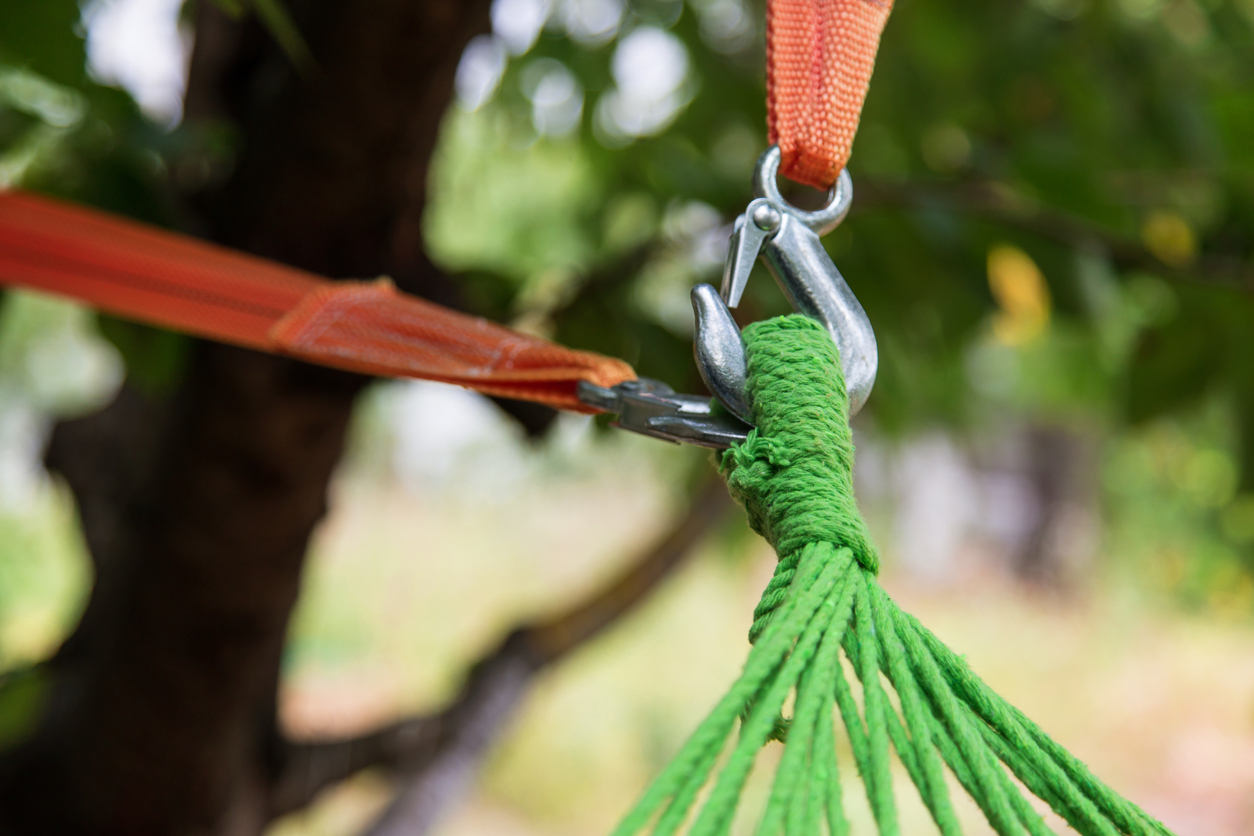We may earn revenue from the products available on this page and participate in affiliate programs. Learn More ›
Laying in a hammock is the epitome of summertime relaxation. Getting the hammock set up, on the other hand, can be a frustrating endeavor. Consult the tips below to make quick and easy work of the process so that soon, you will have gone from hanging the hammock to hanging out in its comfy, swaying embrace.
Before You Begin
Hanging a hammock is an easy DIY task, even for an absolute beginner. Most hammocks come with simple setup instructions, which should always be followed. Pick a hammock that suits your needs, including weight capacity, material, and suitability for indoor or outdoor use. Choosing the wrong hammock for your purposes might result in its being unsafe after hanging or cause the hammock materials to age prematurely from the elements.
Hammock Hardware and Fastening Options
There are many ways to hang a hammock, subject to the type of hammock you own and the space you have available. How you hang a hammock and the hardware you need to complete the job depend on several factors. Consider where you’re using the hammock, and whether this location is meant to be temporary or permanent.
For obvious reasons, it’s important to establish a secure connection at each end of the hammock. Though there are countless hammocks on the market, most fall into one or two design categories. First are traditional hammocks that hang between fixed objects, like backyard trees, with hooks or straps, and then there are hammocks with spreader bars (like the one pictured). Here are the various ways in which to support and connect hammocks:
- Hammock stand: If you’d like to set up a hammock on a patio or in an open space, look for a hammock stand with spreader bars. This self-contained design forces the hammock to remain open, so the occupant never gets wrapped up in a hammock burrito. Unlike traditional hammocks that hang approximately 1.5 feet above the ground, hammocks with spreaders can hang up to 4 or 5 above it. Also, hammock stands with spreader bars hang taut, unlike looser traditional setups.
- Hammock hooks: Hooks can be used for temporary or permanent hammocks to secure them in place. A hammock that’s attached to poles, studs, ceiling joists, and the like uses an eye hook or bracket on each end to secure it to the wall. Note that hardware can harm trees, which is why you should never attach an eye hook to a tree. Attach the hammock directly to the anchor with a hook and short length of chain, and you can adjust hanging height and tension. Hammock hooks are typically large J-hooks, S-hooks, or quality carabiners. J-hooks are best used with the anchor hardware, and S-hooks enable easy adjustment of the tension and length of chain, instead of having to retie a rope or strap. Carabiners can be used for either of these functions.
- Hammock straps: Fastening straps (which may or may not be included with your purchase) are one option for hanging a hammock between two stable objects. These wider straps typically feature a loop on one end and a metal ring on the other. Simply wrap the strap around the tree, pass the loop through the metal ring, then attach the hammock to the ring with S-hook hardware. One virtue of tree-fastening straps is that while effective, they cause no harm to the trees involved.
Hammock Safety
Though hammocks are not typically a significant source of traumatic injuries, proper installation and use help minimize the potential for accidents.
Read the manufacturer’s instructions completely—especially with their guidelines on weight limits—and ensure your hammock is not damaged before using it. When hanging a hammock, use the right tools for the job and avoid improvising with hardware you have on hand that’s “close enough.” Hanging your hammock at the right height reduces the possibility of users falling out and injuring themselves.
Choose a safe location to set up your hammock, avoiding areas over water, or hanging them from structures that aren’t designed to withstand the weight of a hammock, like a car, decorative patio structure, a tree branch, or dead tree. If non-standard structures like a fence are the only ones available to hang your hammock, make sure to properly tie or fasten the hammock tightly, so it won’t move or fall. Never hang a hammock from a structure that has the potential to move (for example, anything on wheels).
How to Hang a Hammock From a Tree
Whether for camping or setting up a comfy nap spot under the backyard trees, the job of attaching a hammock to a tree is fairly simple. The most difficult part of this method is finding sturdy and strong trees that are about 10 to 15 feet apart.
SUPPLIES
Hammock
Tree-saver strap
Carabiner clips or S-hooks
An 8-foot long 4×4 (optional)
Concrete (optional)
Anchoring hardware (optional)
STEP 1: Choose the correct hammock straps and hardware.

For temporary hammock setups, tree straps and ropes are lightweight and easy to pack. Wider tree-saver straps are preferred to thinner straps, ropes, and cords, since these thin options can potentially damage trees. That said, when hanging a hammock from a tree, never hammer or screw anything into the tree bark. Look for straps with multiple loops, or daisy chains, which allow for quick length adjustments.
Refer to your manufacturer’s instructions for their recommendations on hardware. While S-hooks will work, we prefer to use carabiner clips when camping—but they need to be rated to hold the weight.
STEP 2: Find the best spot and the right tree(s) for your hammock.
Choosing the right trees is vital. Look for trees that are 10 to 15 feet apart that are healthy, sturdy, and strong, with a minimum of 6 inches in trunk diameter. If the tree moves after you set up and sit in the hammock, it’s too small, and you need to choose another location. For safety, do not use unhealthy, diseased, or dying trees, which might lead to injury if the tree fails. Certain trees do not fare well with hammocks attached, such as those with thin or delicate bark, like birch or evergreen trees.
Before setup, look up and make sure there aren’t any dead branches, debris, or other items that might fall on the hammock occupant from overhead. If you are hanging multiple hammocks, only attach one hammock per tree.
STEP 3: Install a hammock post a suitable distance away from the tree (optional).
Your hammock needs two strong supports. If you only have one usable tree, you might need to install a hammock post to hold up the other side. Determine how far away to install the post by taking the length of your hammock and adding 2 feet, making sure that the post is no more than 15 feet away from the tree.
Start by digging a hole that’s at least 2 feet deep. You need to use an 8-foot long 4×4 wood post. The post should be weather treated when you buy it; if not, you can waterproof the wood yourself. Next, install anchoring hardware before installing the post, approximately 4 feet off the ground – unless you plan on using the webbing the same as you do on the tree.
Use a carpenter’s level to position the post vertically, with the hardware facing the right direction, however posts can be tilted slightly away from the hammock. Have another person hold the post in place while you pour the concrete, stopping 2 to 3 inches from the top of the hole. Wait at least 24 hours, allowing the concrete to set before hanging your hammock, and covering the top of the concrete with dirt and sod.
STEP 4: Hang the hammock at the best angle and height.

Wrap your anchoring strap around the tree and pass the strap through the fabric or metal loop at the end. These straps must lay flat against the tree and should not be twisted or folded. You want to secure your tree straps, rope, or other suspensions approximately 4 feet up the trees, but you can go a little bit higher if needed.
Clip the carabiner to the end of the hammock and through one of the loops in the strap. The goal is to have the hammock hang at a 30-degree angle on both sides to provide the right amount of force. If your hammock is pulled too tightly, it puts more force on the suspension and anchor points. The average sitting height of a chair is about 18 inches, so you want your hammock to be about this high off the ground when it’s occupied.
STEP 5: Observe your hammock’s weight limit and test it before lying down.
If you have followed these steps and the manufacturer’s instructions, your hammock should be safe to use. Double-check the hammock weight limit before using it. The key to getting into a hammock is to sit slowly and gradually redistribute your weight as you settle into it. If the trees move, or it doesn’t feel secure, get out of the hammock and check your work or relocate the hammock to different trees.
Part of testing out the hammock is to allow it to stretch out, and tighten the straps at the same time. As a result of this test, you’ll often have to readjust the straps a little tighter by using a different loop on the webbing to make the hammock as comfortable as possible.
How to Hang a Hammock on a Porch
No trees for your hammock? No problem! If you have sufficient porch space available, you can use outdoor walls, posts, or ceiling structures to support the weight of someone in a hammock. What’s more, your patio roof or umbrella might provide the perfect amount of shade for an afternoon snooze.
SUPPLIES
Hammock
Stud finder
Anchor bracket or eye hooks with attached J-hooks
Hammock chains
Carabiner clips or S-hooks
STEP 1: Locate the posts, ceiling joists, or wall studs from which your hammock will hang.
Always read the hammock manufacturer’s guidelines before choosing a mounting location. Finding supportive structures is key to how to hang a hammock on a porch. The supports should be load-bearing and functional; decorative elements are not built to withstand the weight of a hammock.
You need two places to secure your hammock, which can be in wood wall studs, solid wood posts, ceiling joists, or a combination of these support items—providing they won’t cause the hammock to hang at a steep angle. Do not rely on metal studs, which the weight of a hammock can bend and potentially cause structural damage. Use a stud finder to locate your studs. At most, they should be approximately 15 feet from each other.
When in doubt, use a hammock hang calculator online, like this one from Hammock Universe.
STEP 2: Select the correct hammock hardware or straps.
Unlike when tying a hammock around a tree or post, hanging a hammock on a porch requires anchoring hardware that will hold the weight of the hammock and user. Tying hammock straps to wooden posts and beams is possible but might damage their surfaces, so we recommend proper hardware installation for porch hammocks.
Use two wall anchors, eye hooks with attached J-hooks, or brackets with a built-in hook. You’ll likely need two short lengths of chain for positioning and supporting the hammock, and two large S-hooks or carabiners can make tension adjustments as needed.
STEP 3: Take measurements and install the hammock hardware.

When installing a porch hammock, make sure to measure the space carefully first. A hammock with a spreader bar generally needs 13 feet between hanging points, and the hardware should be positioned approximately 4 to 5 feet off the ground. Hammocks without the spreader bar are a bit more forgiving with space, since they’re designed to hang with a slumped arch, enabling them to attach in areas that are slightly shorter than their length (although longer than their length is preferred).
You can hang hammocks without spreader bars 6 to 8 feet off the ground. If you’re using a higher beam or ceiling, pick up some long chains or straps to account for any height discrepancies. Locate your stud. If you are using an eye hook, drill a pilot hole into the center of the stud, then tighten the eye hook by hand. Insert a screwdriver into the loop of the eye hook and tighten it more, until only the eye remains visible. If you are using brackets, screw them directly into the stud.
STEP 4: Securely hang the hammock.
Each end of the hammock needs to be mounted at least 4 feet from the floor. If you have taken measurements and installed your hardware correctly, this shouldn’t be an issue. Now you have something secure that will support the weight of the hammock. Attach the ends of the hammock to the anchor fastener using your carabiners, S-hooks, or short chains.
You may not need the chains, but they do provide the ability to adjust the tension of a hammock as needed. Aim for a 30-degree hanging angle on both sides of a hammock without a spreader bar, and have it hang 12 to 18 inches off the ground. Hammocks with a spreader bar hang with a slight arch, but are usually installed almost flat.
STEP 5: Note your hammock’s weight limit and test it out before getting in.

There are a few places to reference weight restrictions for your hammock. You want to check the capacity outlined in your hammock manufacturer’s instructions and ensure the hardware you’ve used is sufficient for the support you need. Many hammocks hold up to 300 or 400 pounds (with some up to 800 pounds), but it’s always best to confirm this figure.
If the hammock and the hardware feel secure, slowly sit down and test it out. If there are no issues once you sit down, slowly recline and let the hammock stretch out. Notice how it feels and make any necessary adjustments to achieve the tension and comfort you desire.
Choosing the Best Spot to Hang a Hammock
Choosing a location for your hammock is perhaps the most difficult part. While you probably don’t have the perfect pair of ideally spaced palm trees on your property, you might very well have two healthy oak, maple, or beech trees that are strong enough to support your weight. Ideally, those hardwoods would be as far apart as the total length of your hammock when fully stretched out.
Traditional hammocks are meant to hang loosely between two trees, with the center dipping down. Since they get attached to points that are six to eight feet high up on nearby trees, you can, in a pinch, consider using tree branches, not tree trunks—so long as the branches offer sufficient heft.
If the trees are too close together, the underside of the hammock is going to scrape along the ground. If the trees are too far apart, you’ll need to extend the reach of the hammock by means of an added-on rope or chain. While there’s a simple remedy for the latter problem, there’s unfortunately no fix for the former (other than to buy another, smaller hammock).
Note, however, that it can be a mistake to extend a hammock any more than 18 inches at each end. Doing so leaves it vulnerable to ripping. So if you fully anticipate having to add extensions, only consider buying a hammock outfitted with a spreader bar to inhibit rips.
Final Thoughts
Knowing how to hang a hammock will keep you hanging comfortably off the ground instead of falling out onto the grass or floor. Additionally, hanging your hammock with a loose curve that’s not too low, stiff, or applies too much force, puts less stress on the straps, hardware, and hammock—helping it feel more comfortable and potentially last longer.
If you have a hammock with a spreader bar, remember that you need more room for installation. Hammocks without the spreader bar need a loose curve to achieve the right angle and tension. For hammocks that you want to use long term, always invest in quality suspension hardware that stands up to the elements.
Remember that the wonderful thing about hanging a hammock is that once you’ve finished the job, your reward is right there in front you. Collapse into your new favorite spot—hey, you’ve earned a break!
FAQs

Now that you’ve learned how to set up a hammock, you may still have questions, or perhaps you’re looking for specific information about this DIY activity. Here are some frequently asked questions and answers about hanging a hammock.
Q. How high should a hammock be off the ground?
The general rule of thumb is to hang your hammock approximately at seat height when occupied. The average seat height is around 18 inches tall, allowing hammock users to sit comfortably with their feet on the ground when they are not reclining.
Q. How far apart should hammock posts be?
The distance between hammock posts varies, depending largely on the length of the hammock. Many hammocks require a distance of 10 to 15 feet between posts. For hammocks that do not have a spreader bar, typically ensure a minimum of the length of the hammock plus 2 feet between the hammock and posts.
Hammocks with a spreader bar generally require a minimum of 13 feet between posts. If you don’t want to deal with hammock posts, a hammock stand is an easy option for many spaces.
Q. Can a fence post hold a hammock?
It is possible for a fence post to support a hammock, however, you must be certain that the fence is stabilized in concrete that is deep enough to provide structural support. In this way, you’re using a fence post in a similar way as the hammock post outlined above. This technique will not work for decorative fences, fence paneling, or posts that are not supported by concrete.


